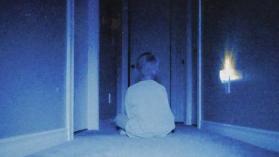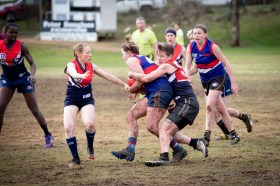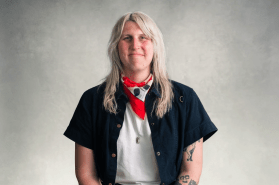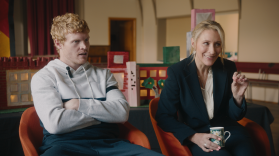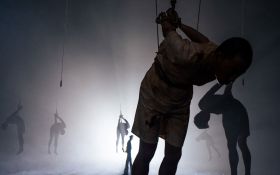Image: Tima, 5 weeks, statelessness, Amsterdam, Anoek Steketee, 2017. What kind of heritage can this child have?
Each year the National Film and Sound Archive runs a Digital Directions Symposium to explore key issues in the preservation sector. What do we collect? How do we do it? How will it be used? Get it wrong and we have no heritage, or hide it in deep caves beneath a bureaucratic dragon.
This year the GLAM (gallery, library, archive, museum) sector focused on the users of digital collections. The users, advocates and professionals in the screen archival community were also keen to see Jan Müller, the new CEO of the NFSA, in action for the first time.
The entire proceedings are available here as a video, opening with his keynote address.
Dominic Case, an expert in post production and a passionate advocate of archiving, has written two articles about the proceedings. Here is the first…
—————
DIGITAL DIRECTIONS 2017 (1)
Morning: engaging with digital collections – what do users want?
‘It’s not about preservation or digitisation – it’s about what we do with it.’
To hear these words from Jan Müller, the new CEO of the National Film and Sound Archive, might send a chill down the spines of committed archivists keen to learn what new directions he might have in mind for the archive. But to be fair, this was in his keynote speech introducing the one day Digital Directions conference held at NFSA in Canberra.
So are we now to take preservation for granted? David Fricker, Director-General of the National Archives of Australia clarified ‘we’re not in the preservation business: everything is about access’. But then ‘of course you can’t do that unless you have a collection’. And later, commenting on the uncertain longevity of digital data, ‘Digital records are records on life support’.
It was an illustrious line-up of speakers from the GLAM (Galleries, Libraries, Archives, Museums) sector including the heads of NFSA, NLA, NAA, ACMI and ANAT (Australian Network for Art and Technology) as well as of Digital New Zealand. There too were an academic, an indigenous curator, a couple of software/data people and – yes, just one – filmmaker. For a conference subtitled ‘The User Experience’ this seemed a little one-sided, although Jo-anne McGowan of Stranger than Fiction Films certainly provided a clear insight in to how one user is working with collections. But more of that later.
Know your user
Müller’s introduction gave a whirlwind tour of some of the latest digital interventions in the way galleries and museums around the world follow their aims to ‘know, educate, engage and teach’. Galleries are drawing on techniques from the retail shopping mall world to track visitors, noting how long they spend in front of each painting, and relating that data to everything else known about the visitor from their on-line ticket booking, such as their social media use and other interests.
The Rijksmuseum in Amsterdam discovered that seventy per cent of its visitors were ‘culture snackers’, who were heavy users of the internet but had no art background. So the ‘engagement’ part of the mission must essentially involve the internet, like this. (This of course goes without saying for institutions such as NFSA with no public on-site presence.)
A closed collection . . .
The general thrust of the talks that followed was all about getting more content out to more users, but the first speaker, Shaun Angeles, from the Strehlow Research Institute in Alice Springs, provided a different view. The Strehlow collection consists of thousands of ritual objects, photographs,16mm films and field diaries collected around Alice Springs by anthropologist Ted Strehlow between the1930s and 1970s. Many of these items show or describe culturally-sensitive information, songs, ceremonies and family trees that should only be seen by Arrernte people. The Institute has only recently engaged indigenous curators such as Shaun Angeles to manage and understand its significance. He made it clear that, digitised or not, the collection would not be put online, and much of it would only be made available to people with strong connections to local family or culture.
He noted that the material was proving useful for elders to learn and in turn teach traditions which they themselves had ‘for various historical reasons’ not learned, and which in some cases had already been forgotten.
However Angeles felt that this introduced a serious risk that digital assets might eliminate the role of the elders and the respect that their knowledge brought to them, and therefore the nuances of relationships in the community.
Furthermore, his concern with making digital copies was that a hard drive or USB stick could easily or carelessly be lost, and once lost, its sacred/secret nature was forever compromised.
And a very open one
Fiona Fieldsend of Digital NZ (A-tihi o Aotearoa) presented a very different view. A division of the National Library of New Zealand, Digital NZ provides access to over thirty million digital items via a very powerful yet flexible, user-oriented search engine. Impressively, every link returned in a search comes with a thumbnail image. Users can also build and upload their own search filters, create links, and post their own collected results. More advanced users and developers can collect and compare metadata using Digital NZ’s own ‘Supplejack’ tool.
Digital NZ encourages users to use these resources creatively – such as in their annual ‘gif-it-up’ competition, for user-created gif images using public-domain digital images sourced through their website. This is run jointly with the Digital Public Library of America – one of an increasing number of collaborations made possible by the online world.
Gavin Tapp of GovHack elaborated on the business of making data useful. The annual Govhack ‘hackathon’ is an event in which competitors have a weekend to access and combine open sources of government data and present and use the results in an innovative way. While this obviously covers a far wider range than the cultural sector, the guidelines for good data (a shareable API [Application Program Interface], accessible, easy to use, up to date etc) are just the same.
‘Any colour so long as it’s black’ (and white)
Back to screen images: Jo-anne McGowan (producer of Mountain, and David Stratton’s A Cinematic Life) is currently working on a four-part series Australia in Colour which will trace Australian history entirely through colorised film clips. All the original material will be black and white archival material, and it will all be colorised.
In McGowan’s words, ‘history didn’t happen in back and white’ but audiences, she says, are more emotionally affected by colour images, so she will use ‘the subterfuge of colour’ to better engage the audience.
McGowan argued later that changing records is not the same as falsifying records, emphasising the amount of research that went in to ensuring the colours were authentic, and the original material remained unchanged.
She found that archives were focussed on the digitising process, but she pleaded for people who really knew the collection and everything about its subject matter. Search tools that simply provided written results were often unhelpful, and she called out for thumbnail images to help identify useful results.
In the technical colorising process, carried out by French company Composite Films, images are digitised (at 4K) then repaired and dust-busted before key frames are painstakingly colorised. Animation-like software then tracks each coloured object through in-between frames to produce the result…
Colorization Showreel 2014 – Composite Films from Composite Films on Vimeo.
Discussion afterwards considered, inconclusively, a distinction between colorising actuality material that is shot and used entirely as a record of the subject, and colorising feature films where the film itself is a creative artefact that exists between the scenes in front of the camera and the eventual viewer.
Discussion: copyright and security
What emerged through this first session was that users are now enabled not just to search for and use digital material, but – much more than ever before – to alter it to for their own needs. The question of copyright was bound to emerge fairly quickly in the panel discussion that followed. GovHack and Digital NZ insist on using open source or open licensed material, but noted that acknowledgement of sources was vital. In a world of ‘fake news’ the concept of images that were ‘realistic but wrong’ was a crucial one. How was authenticity ensured? Gavin Tapp suggested that Google searches tended to return earlier and more authoritative sources first.
Meanwhile an audience member suggested that ‘copyright is an invention of the devil’ and that sharing is the most reliable method of ensuring preservation (though Shaun Angeles insisted that sharing must only be with the right people).
What is the main threat to data (or image) security: the possibility that it could be lost entirely due to poor (or no) archiving processes; the chance of it falling into the wrong hands, or the chance of it being shared and altered?
Read more: Part two is here
Dominic Case
20 October 2017

